Related Research Articles

The police are a constituted body of persons empowered by a state, with the aim to enforce the law, to ensure the safety, health and possessions of citizens, and to prevent crime and civil disorder. Their lawful powers include arrest and the use of force legitimized by the state via the monopoly on violence. The term is most commonly associated with the police forces of a sovereign state that are authorized to exercise the police power of that state within a defined legal or territorial area of responsibility. Police forces are often defined as being separate from the military and other organizations involved in the defense of the state against foreign aggressors; however, gendarmerie are military units charged with civil policing. Police forces are usually public sector services, funded through taxes.
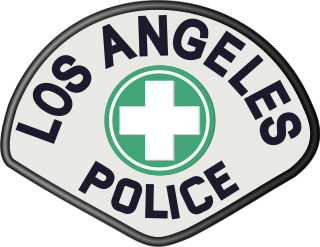
The Los Angeles Police Department (LAPD), officially known as the City of Los Angeles Police Department, is the municipal police department of Los Angeles, California. With 9,974 police officers and 3,000 civilian staff, it is the third-largest municipal police department in the United States, after the New York City Police Department and the Chicago Police Department.

The New York City Police Department (NYPD), officially the City of New York Police Department, established on May 23, 1845, is the primary municipal law enforcement agency within the City of New York, and the largest and one of the oldest in the United States.

The New South Wales Police Force is the primary law enforcement agency of the state of New South Wales, Australia. Divided into Police Area Commands (PACs), for metropolitan areas and Police Districts (PDs), for regional and country areas, the NSW Police Force consists of more than 400 Police stations and over 18,000 officers, who are responsible for covering an area of 801,600 square kilometres and a population of more than 8.2 million people.

Mounted police are police who patrol on horseback or camelback. Their day-to-day function is typically picturesque or ceremonial, but they are also employed in crowd control because of their mobile mass and height advantage and increasingly in the UK for crime prevention and high visibility policing roles. The added height and visibility that the horses give their riders allows officers to observe a wider area, and it also allows people in the wider area to see the officers, which helps deter crime and helps people find officers when they need them. When employed for crowd control, there is a risk that some people may be trampled. Due to this, authoritarian regimes often use mounted police to supress protests, as the public generally does not view these "accidental" deaths as resulting from a deliberate use of deadly force. In at least one case this has resulted in the police officer riding the horse to be sued.
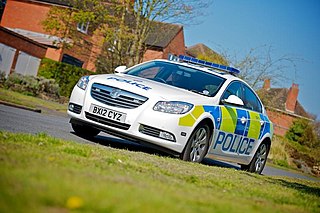
A police car is a ground vehicle used by the police for transportation during patrols and to enable them to respond to incidents and chases. A police car is typical used by police officers so they can reach the scene of an incident quickly, patrol an area, and transport and temporarily detaining suspects. Police officers also use their vehicle to use their police radio, laptop and \or tablet, all while providing a visible deterrent to crime. Some police cars are specially adapted for certain locations or for certain operations. Police cars typically have rooftop flashing lights, a siren, and emblems or markings indicating that the vehicle is a police car. Some police cars may have reinforced bumpers and searchlights to illuminate darkened areas.
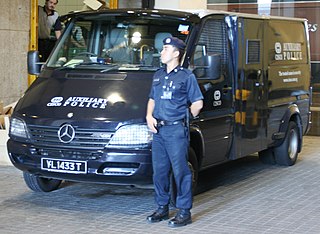
Auxiliary police, also called special police, are usually the part-time reserves of a regular police force. They may be armed or unarmed. They may be unpaid volunteers or paid members of the police service with which they are affiliated. The police powers auxiliary units may exercise vary from agency to agency; some have no or limited authority, while others may be accorded full police powers.

Essex Police is a territorial police force responsible for policing the county of Essex, in the East of England. Essex Police is responsible for a population of over 1.8 million people and an area of 1,420 square miles (3,700 km2).

Hampshire Constabulary is the territorial police force responsible for policing the counties of Hampshire and the Isle of Wight in South East England, United Kingdom.
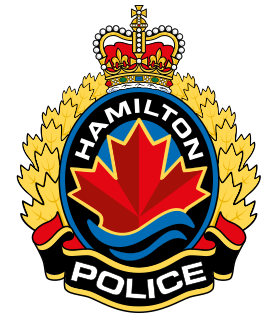
The Hamilton Police Service (HPS) is the police service of the City of Hamilton, Ontario, Canada. With 829 officers and 414 civilians employed under the service. It serves roughly Hamilton’s 545,000 residents.
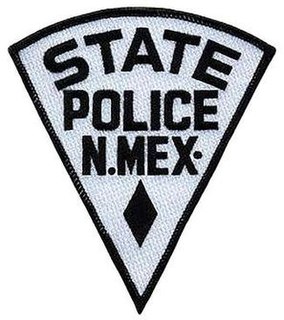
The New Mexico State Police is the state police agency for New Mexico, which has jurisdiction anywhere in the state. It was created to protect the lives, property and constitutional rights of people in New Mexico. The State Police is a division within the New Mexico Department of Public Safety.

The Dubai Police Force is the 17,500 strong police force for the Emirate of Dubai, in the United Arab Emirates. They come under the jurisdiction of the ruler of Dubai, and they cover an area of 4,114 square kilometres and a population of 2.8 million people.

A random checkpoint is a military and police tactic. In a military context, checkpoints involve the setup of a hasty roadblock by mobile truck- or armored vehicle-mounted infantry to disrupt unauthorized or unwanted movement or military activity and to check for valid identification and search for contraband, fugitives, or weapons that are not permitted in civilian hands. Random checkpoints are set up to achieve surprise, as opposed to known permanently located checkpoints, which suspects could circumvent. They are often established in locations where they cannot be observed by approaching traffic until it is too late to withdraw and escape without being observed.
The following outline is provided as an overview of and introduction to law enforcement:
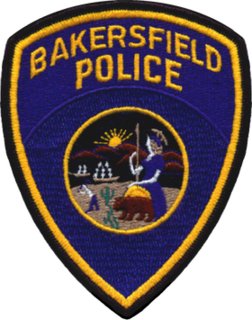
The Bakersfield Police Department (BPD) is the agency responsible for law enforcement within the city of Bakersfield, California, in the United States. It has over 590 officers and professional staff, covering an area of 151.2 square miles (392 km2) serving an urban population of more than 400,000. The current chief of the department, since April 2020, is Greg Terry. The department protects the city, split between two areas and six zones with two stations, the main department headquarters and the west side substation. The department administration is made up of the chief of department, two assistant chiefs, four captains and eleven lieutenants.
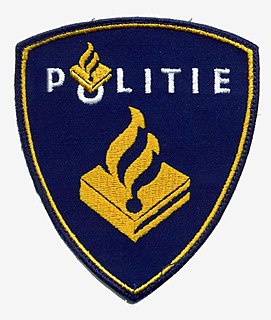
National Police Corps, colloquially in English as Dutch National Police or National Police Force, is divided in ten regional units, a central unit, the police academy, police services center, and national control room cooperation. The law-enforcement purposes of these agencies are the investigation of suspected criminal activity, referral of the results of investigations to the courts, and the temporary detention of suspected criminals pending judicial action. Law enforcement agencies, to varying degrees at different levels of government and in different agencies, are also commonly charged with the responsibilities of deterring criminal activity and preventing the successful commission of crimes in progress. The police commissioner in the Netherlands is Henk van Essen since May 1, 2020.
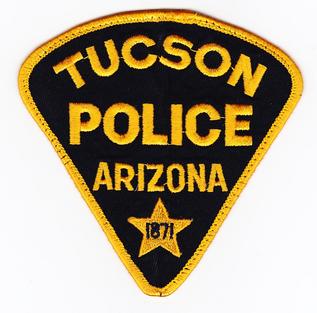
The Tucson Police Department is the law enforcement agency responsible for the city of Tucson, Arizona.
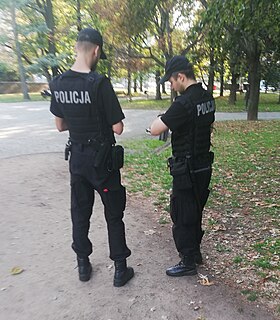
In police terminology, a beat is the territory that a police officer is assigned to patrol. Beats are used to effectively divide available officers across a law enforcement agency's jurisdiction, ensuring organized police presence across a wide area.
The National Police of Ukraine, often simply referred to as the Politsiya, is the national, and only, police service of Ukraine. It was formed on 3 July 2015, as part of the post-Euromaidan reforms launched by Ukrainian president Petro Poroshenko, to replace Ukrainian's previous national police service, the Militsiya. On 7 November 2015, all the remaining militsiya were labelled "temporary acting" members of the National Police.

A mobile field force (MFF), within the context of United States law enforcement, is a large element of police officers specially organized to support anti-riot operations through the use of maneuver tactics aimed at dispersing crowds during their embryonic phase or extracting agitators and leaders from larger groups. The mobile field force concept was created by the Miami-Dade Police Department in the 1980s.
References
- ↑ Safer New Mexico - FAQ Page. "What is a saturation patrol?" Safer New Mexico Now. Retrieved January 19, 2009.
- 1 2 Preventing Crime - What Works, What Doesn't, What's Promising. Chapter 8 - Policing for Crime Prevention. 1996. Department of Criminology and Criminal Justice, University of Maryland, College Park.